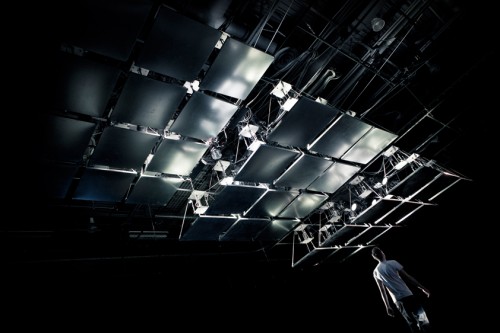There I was, lying on my back, the sharp bang of shots coming closer and louder. I stood up and I could feel air pressure from the vibrations of the ceiling as it dropped nearer to my head, as close as a mere foot away. If this thing fell, I’d be dead on the spot. I wasn’t in a bunker–I was experiencing Cinétose, Projet EVA’s latest installation, which debuted at Montréal’s electronic arts festival, Elektra, this month at UsineC.
Projet EVA describe Cinétose as a
“large scale installation comprised of steel sheets that are used both as sound instrument and scenic apparatus. Attached to a mobile grid over the audience, the large steel plates perform a series of movements while descending towards the public.”
It’s also, I suppose, performance art: a piece performed by a giant robot and dramatically scored to what I can’t quite refer to as music. In my video below, you’ll hear a resounding and reverberating banging. That is the sound of the steel sheets each time they are struck by the pneumatic pistons hidden behind their shiny façade. The robotic choreography is also a sound composition, because every one of its movements makes a sound. The movement of the structure and its independent components results in a kind of mechanical score (which, it should be noted, is backed by atmospheric sounds played live on analog synthesizers by Projet EVA). However, despite there being rhythmic elements to the resultant percussive sounds, the timing between the bangs is never maintained at any point, which means the rhythmic structure never becomes musical. Basically, the bangs are not beats, and in this case I’m glad. The worry that comes when a mechanical sound installation begins a foray into “music” is that it will veer away from making a case for sound – the eternal underdog of visual art.
Simon Laroche, a member of and guiding force behind Cinétose, tells me that the original idea came to him years ago when he had built a mechanical drumming robot doll. Inspired by the mechanical element that allowed the doll to automatically move its arms to make a “clack clack clack” sound with drumsticks on a drum, he decided to make a piece that used the mechanism itself as the visual apparatus. The non-personified, unmasqued robot, combined with surreptitious lighting and sound design, makes the work feel theatrical, even performative. In this case, it is the robotic structure that performs, and because the installation appears to be in many ways a part of the building–a set of scaffolding, a large grid, multiple cables–the room itself becomes an important aspect of the work as it fills with reverberating sounds through the performance’s duration.
As the large-scale grid is lowered toward the public, it displaces visitors and skews spatial representation. Our sense of personal space changes–expanding and contracting–while the immersive sounds become louder and that much more physical. In fact, it becomes loud enough that you can feel that sound is movement, and that sound is vibrations, as the grid seems to hover perilously above visitors’ heads. Cinétose operates on, and plays with, the idea of common sense which is based on a model of recognition, and an expression of performing society’s good will: as a visitor you hope and trust that the booming structure won’t fall and crush you. (I overheard that the venue, UsineC, had to obtain insurance coverage for millions of dollars of damage for Cinétose just in case that did happen!). Nonetheless, there is a fun “cringe factor” in experiencing this sensorially astounding work.
Interestingly, Laroche told me that before Projet EVA debuted Cinétose this month, the group had experimented with making the work interactive, i.e. with allowing the public to make contact with the steel sheets. However, they decided against it for fear that the artistic experience would devolve into mindless entertainment. It is a point that dominates that strand of installation art involving “immersive environments,” and is an important enough reason to continue looking at Projet EVA’s work closely in the future.






Pingback: A different direction daily « Hargie